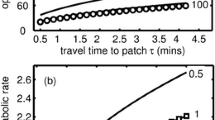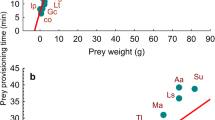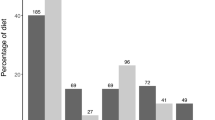Summary
We examined the behavior of a central place forager, the American robin (Turdus migratorius), with emphasis on the self-feeding component of foraging bouts. Among individuals the mean percentage of all prey captured that was consumed by adults varied from 10% to 60% (x ; 31%). Size of prey appeared important in determing whether the prey was eaten; adults generally consumed small prey and fed larger prey items to their young. In addition, females consumed more prey per bout than males, although rates of prey consumption were similar between sexes. For those robins in which a correlation was demonstrated between bout duration and amount of prey captured, amount of prey eaten by adults influenced bout length more strongly than size of the load. Attempts to model the robins' foraging process indicated that prey size, quantity of prey in the bill, and time away from the nest were important in determining when to terminate a bout. The rate at which robins foraged in their territory increased with age of the nestlings. In addition, mated pairs partitioned territories roughly in half, presumably as a mechanism for increasing foraging efficiency in a fairly homogeneous environment. Foraging activity declined as distance from the nest increased, but not in the manner predicted by optimality models.
Similar content being viewed by others
References
Andersson M (1981) Central place foraging in the Whinchat, Saxicola rubetra. Ecology 62:538–544
Aronson RB, Givnish TJ (1983) Optimal central place foragers: a comparison with null hypotheses. Ecology 64:395–399
Carlson A (1985) Central place food caching: a field experiment with red-backed shrikes (Lanius collurio L.). Behav Ecol Sociobiol 16:317–322
Carlson A, Moreno J (1985) Central place foraging in wheaters (Oenanthe oenanthe L.): foraging itineraries when feeding nestlings. Behav Ecol Socobiol 16:307–316
Conover WJ (1971) Practical nonparametric statistics. Wiley and Sons, New York
Drent RH, Daan S (1980) The prudent parent: energetic adjustments in avian breeding. Ardea 68:225–252
Gochfeld M, Burger J (1984) Age differences in foraging behavior of the American robin (Turdus migratorius). Behaviour 88:227–239
Harkness RD, Maroudas NG (1985) Central place foraging by an ant (Cataglyphis bicolor Fab.): a model of searching. Anim Behav 33:916–928
Hegner RE (1982) Central place foraging in the White-fronted bee-eater. Anim Behav 30:953–963
Janetos AC, Cole BJ (1981) Imperfectly optimal animals. Behav Ecol Sociobiol 9:203–210
Kacelnik A (1984) Central place foraging in the starling (Sturnus vulgaris) I: patch residence time. J Anim Ecol 53:283–301
Kamil AC, van Riper C (1982) Within-territory division of foraging space by male and female amakihi (Loxops virens). Condor 84:117–119
Krebs JR, Stephens DW, Sutherland WJ (1983) Perspectives in optimal foraging. In: Brush AH, Clark AG (eds) Perspectives in ornithology. Cambridge University Press, Cambridge, pp 165–216
O'Brien WJ, Slade NA, Vinyard GL (1976) Apparent size as the determinant of prey selection by bluegill sunfish (Lepomis macrochirus). Ecology 57:1304–1310
Orians GH, Pearson NE (1979) On the theory of central place foraging. In: Horn OJ, Stairs BR, Mitchell RD (eds) Analysis of ecological systems. Ohio State University Press, Columbus, pp 155–177
Robins JD (1971) Differential niche utilization in a grassland sparrow. Ecology 1065–1070
Royama T (1966) Factors governing feeding rates, food requirement and brood size of nestling great tits Parus major. Ibis 108:315–347
Sargent RC, Gross MR (1985) Parental investment, decision rules and the Concorde fallacy. Behav Ecol Sociobiol 17:43–45
Schoener TW (1979) Generality of the size-distance relation in models of optimal feeding. Am Nat 14:902–914
Schoener TW (1981) An empirically based estimate of home range. Theor Popul Biol 20:281–325
Swihart RK, Slade NA (1985) Testing for independence of observations in animal movements. Ecology 66:1176–1184
Tinbergen J (1981) Foraging decisions in Starling (Sturnus vulgaris L.). Ardea 69:1–67
Waage JK (1979) Foraging for patchily-distributed hosts by the parasitoid, Nemeritis canascens. J Anim Ecol 48:353–371
Williams GC (1966) Adaptation and natural selection: a critique of some current evolutionary thought. Princeton University Press, Princeton, NJ
Author information
Authors and Affiliations
Rights and permissions
About this article
Cite this article
Swihart, R.K., Johnson, S.G. Foraging decisions of American robins: somatic and reproductive tradeoffs. Behav Ecol Sociobiol 19, 275–282 (1986). https://doi.org/10.1007/BF00300642
Received:
Accepted:
Issue Date:
DOI: https://doi.org/10.1007/BF00300642




